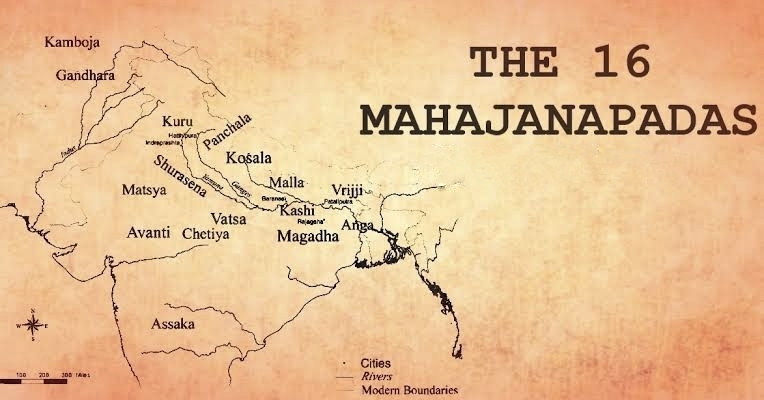
Project On The Rise Of The Mahajanapadas For Class 12
Acknowledgement:
I am deeply grateful for the support and guidance provided by various individuals throughout the completion of this project on The Rise of the Mahajanapadas. Without their assistance, this project would not have been possible. In particular, I would like to express my sincere gratitude to the following:
First and foremost, I would like to thank my teacher [Teacher’s Name] for their unwavering support, valuable insights, and continuous encouragement. Their expertise in the subject matter has been instrumental in shaping this project and guiding me towards a deeper understanding of the Mahajanapadas.
I would also like to extend my gratitude to my classmates for their collaborative spirit and engaging discussions. Their contributions and feedback during group discussions and brainstorming sessions have been invaluable in refining the content and structure of this project.
Furthermore, I am grateful to the school administration for providing access to various resources, including books, research materials, and online databases. These resources have played a crucial role in conducting thorough research and gathering relevant information on the topic.
I would like to acknowledge the scholars and historians whose extensive research on the Mahajanapadas has laid the foundation for our understanding of this period. Their published works, articles, and scholarly papers have served as primary sources of information and have greatly enriched the content of this project.
Last but not least, I am grateful to my family and friends for their constant support and encouragement throughout this endeavor. Their belief in my abilities and their motivation have been vital in keeping me focused and determined to complete this project to the best of my abilities.
In conclusion, I express my heartfelt appreciation to all those who have played a role, directly or indirectly, in the successful completion of this project on The Rise of the Mahajanapadas. Their guidance, contributions, and encouragement have been invaluable, and I am grateful for their unwavering support.
Introduction:
The ancient history of India is replete with remarkable developments and significant milestones that have shaped its rich cultural heritage. Among these, the emergence of the Mahajanapadas stands as a pivotal period, representing a significant transition in the political landscape of ancient India. This project seeks to delve into the rise and significance of the Mahajanapadas, shedding light on their administrative systems, cultural contributions, and socio-political structures.
The Mahajanapadas, meaning “great kingdoms” or “great republics, ” were powerful territorial states that arose in the Indian subcontinent during the 6th century BCE. These states marked a significant departure from the earlier tribal societies and laid the foundation for subsequent political developments in the region. Exploring this crucial phase of Indian history allows us to gain insights into the dynamics of power, governance, and social structures that prevailed during this era.
By examining the rise of the Mahajanapadas, we can better understand the factors that led to their emergence. Various elements contributed to the rise of these states, including territorial expansion, strategic alliances, economic prosperity, and military prowess. Studying these factors provides valuable insights into the political aspirations and ambitions of the rulers, as well as the geopolitical environment of ancient India.
Furthermore, exploring the administrative systems of the Mahajanapadas provides a glimpse into the governance mechanisms of the time. These states were characterized by a central authority, usually a king or a council of elders, who exercised control over their territories. Understanding the administrative structures, revenue systems, and decision-making processes of the Mahajanapadas offers valuable insights into the governance practices prevalent during that era.
The cultural contributions of the Mahajanapadas were equally significant. These states witnessed a flourishing of art, literature, and religious developments. Literature in the form of epics, philosophical treatises, and historical chronicles emerged during this period, providing valuable insights into the social and intellectual milieu of ancient India. Artistic expressions, such as sculptures, paintings, and architectural achievements, exemplify the artistic and cultural advancements of the time.
Additionally, the socio-political structures of the Mahajanapadas offer glimpses into the social hierarchy, economic activities, and inter-regional trade networks that thrived during this period. Understanding these structures helps us appreciate the social complexities and economic systems that underpinned ancient Indian society.
Studying the rise of the Mahajanapadas is of utmost importance as it allows us to comprehend the historical roots of India’s political landscape. These territorial states played a crucial role in shaping subsequent political developments, including the rise of large empires and the consolidation of power in the region. The administrative, cultural, and socio-political systems of the Mahajanapadas left a lasting impact on ancient India, and their study provides a foundation for understanding the subsequent phases of Indian history.
In conclusion, this project on the rise of the Mahajanapadas aims to explore the significance of this pivotal period in Indian history. By examining the administrative systems, cultural contributions, and socio-political structures of the Mahajanapadas, we can gain valuable insights into ancient India’s political dynamics and its lasting impact on the subcontinent.

The Rise of the Mahajanapadas: An Overview:
During ancient India’s historical timeline, the emergence of the Mahajanapadas marked a significant shift in the political landscape of the subcontinent. In this section, we will delve into the concept of the Mahajanapadas, their origins, and their significance in the context of ancient India. We will also explore the factors that led to the rise of these territorial states and highlight their key characteristics.
The term “Mahajanapadas” refers to the “great kingdoms” or “great republics” that emerged in ancient India during the 6th century BCE. Prior to the rise of the Mahajanapadas, the Indian subcontinent was predominantly characterized by tribal societies, with limited central authority or political organization. However, with the passage of time, various factors contributed to the formation of larger territorial states, leading to the emergence of the Mahajanapadas.
One significant factor in the rise of the Mahajanapadas was territorial expansion. As neighboring tribes and small chiefdoms sought to assert their dominance and secure resources, conflicts and wars arose. Through military conquests and strategic alliances, some rulers were able to consolidate their power and expand their territories, laying the foundation for the formation of the Mahajanapadas.
Economic prosperity also played a crucial role in the rise of the Mahajanapadas. The fertile river valleys, abundant natural resources, and flourishing trade networks provided a conducive environment for economic growth. The control over important trade routes and access to valuable resources allowed certain regions to accumulate wealth and influence, leading to the rise of powerful territorial states.
Furthermore, the rise of the Mahajanapadas was influenced by political ambitions and power struggles among ruling elites. The desire to control larger territories, exercise authority over neighboring tribes, and establish hegemony prompted rulers to form alliances, engage in diplomatic negotiations, and employ military tactics. These power dynamics contributed to the rise and expansion of the Mahajanapadas.
The key characteristics of the Mahajanapadas varied across different regions, reflecting their unique socio-political and cultural backgrounds. Some Mahajanapadas were ruled by powerful monarchs who exercised absolute authority, while others were republics where decisions were made collectively by assemblies or councils. The administrative systems of the Mahajanapadas involved the delegation of power to local rulers and officials who governed specific regions under the overarching authority of the king or council.
The rise of the Mahajanapadas brought about significant changes in the political landscape of ancient India. It marked a transition from small tribal societies to larger territorial states with more complex administrative structures. The consolidation of power and the emergence of these states laid the foundation for subsequent political developments, including the rise of empires such as the Maurya and Gupta empires.
In conclusion, the rise of the Mahajanapadas was a transformative phase in ancient Indian history. Through territorial expansion, economic prosperity, and power struggles, these territorial states emerged and played a crucial role in shaping the political landscape of the subcontinent. Understanding the origins and significance of the Mahajanapadas provides valuable insights into the dynamics of ancient India’s political evolution and sets the stage for further exploration of this fascinating period.

Examples of Mahajanapadas:
The Mahajanapadas era witnessed the emergence of several powerful territorial states across the Indian subcontinent. In this section, we will delve into the in-depth analysis of prominent Mahajanapadas, highlighting their territorial boundaries, rulers, economic activities, and cultural contributions. By examining specific examples, such as Magadha, Kosala, Vatsa, Avanti, and others, we can gain a better understanding of their individual contributions and regional variations.
- Magadha: Located in present-day Bihar, Magadha was one of the most prominent Mahajanapadas. It was ruled by notable dynasties such as the Haryanka and later the Maurya dynasty. Magadha’s territorial boundaries expanded significantly under rulers like Bimbisara and Ashoka. It was known for its agricultural productivity and played a crucial role in trade and commerce. Magadha’s cultural contributions include the patronage of Buddhism and the establishment of the renowned Nalanda University.
- Kosala: Situated in present-day Uttar Pradesh, Kosala was a significant Mahajanapada ruled by the famous dynasty of the Ikshvakus. It encompassed important cities like Shravasti and Ayodhya. Kosala was renowned for its prosperous agriculture, particularly rice cultivation. It also had an active trade network, contributing to its economic prosperity. Kosala was culturally significant as it was the birthplace of Lord Rama, a central figure in Hindu mythology.
- Vatsa: Vatsa, situated in present-day Uttar Pradesh, was ruled by the Vatsa dynasty. Its capital was Kaushambi, an important center of trade and commerce. Vatsa was known for its skilled artisans and craftsmen, contributing to its economic prosperity. It also played a crucial role in the spread of Buddhism, with important Buddhist monasteries located in the region.
- Avanti: Avanti was a prominent Mahajanapada situated in present-day Madhya Pradesh. It was ruled by the Pradyota dynasty. The capital of Avanti was Ujjayini (modern-day Ujjain), which served as a significant center of political, economic, and cultural activities. Avanti was known for its flourishing trade, with connections to both northern and southern India. It was also associated with the spread of Jainism, as the famous Jain Tirthankar Mahavira was believed to have attained Nirvana in Pawapuri, an important city in Avanti.
These are just a few examples of the diverse and influential Mahajanapadas that emerged during this era. Each Mahajanapada had its unique characteristics, territorial boundaries, ruling dynasties, economic activities, and cultural contributions. By examining these specific examples, we can gain a deeper understanding of the regional variations and individual contributions of the Mahajanapadas, thus appreciating the diverse and rich tapestry of ancient Indian history.
Importance of Studying the Rise of the Mahajanapadas:
The study of the rise of the Mahajanapadas holds immense importance in understanding the historical and cultural development of ancient India. In this section, we will explore the significance of studying the Mahajanapadas and how they shaped future political systems, influenced the socio-cultural fabric of ancient India, and contributed to the formation of larger empires. Additionally, we will discuss the lasting impact of the economic and administrative systems developed during this period on subsequent political developments.
Foundation for Future Political Systems: The Mahajanapadas laid the foundation for future political systems in ancient India. These territorial states represented a significant shift from small tribal societies to larger political entities with structured administrative systems. By studying the rise of the Mahajanapadas, we gain insights into the early forms of governance, decision-making processes, and the consolidation of power. This understanding becomes crucial in tracing the evolution of political systems and institutions that emerged in subsequent centuries, including the formation of larger empires such as the Maurya and Gupta empires.
Influence on Socio-cultural Fabric: The Mahajanapadas had a profound influence on the socio-cultural fabric of ancient India. Each Mahajanapada had its distinct cultural traditions, artistic expressions, and religious practices. By studying these territorial states, we gain insights into the diverse cultural heritage of ancient India, including the development of literature, art, architecture, and religious beliefs. The Mahajanapadas also served as centers for intellectual and philosophical debates, contributing to the intellectual legacy of the subcontinent.
Contribution to the Formation of Larger Empires: The Mahajanapadas played a pivotal role in the formation of larger empires in ancient India. Some Mahajanapadas, such as Magadha, expanded their territories and established regional dominance. The power and resources accumulated by these states were instrumental in the subsequent rise of larger empires. For example, the Maurya Empire, founded by Chandragupta Maurya, emerged from the consolidation of Magadha and expanded to become one of the largest empires in ancient Indian history. The study of the Mahajanapadas helps us understand the socio-political dynamics that contributed to the formation and expansion of such empires.
Lasting Impact on Economic and Administrative Systems: The economic and administrative systems developed during the Mahajanapada period had a lasting impact on subsequent political developments. The Mahajanapadas engaged in agriculture, trade, and commerce, leading to the development of economic networks and the growth of urban centers. The administrative structures, revenue systems, and governance mechanisms employed by the Mahajanapadas served as prototypes for future political systems. By studying these systems, we gain insights into the economic foundations and administrative structures that shaped ancient Indian society.
In conclusion, studying the rise of the Mahajanapadas is crucial for understanding the historical significance of ancient India. These territorial states laid the foundation for future political systems, influenced the socio-cultural fabric of the subcontinent, and contributed to the formation of larger empires. The economic and administrative systems developed during this period had a lasting impact on subsequent political developments. By examining the Mahajanapadas, we gain a comprehensive understanding of ancient Indian history and appreciate the intricate interplay between

How Can We Make It Happen?:
This section will focus on the research methods and resources that can be employed to study the rise of the Mahajanapadas effectively. It will include suggestions on utilizing primary and secondary sources, such as archaeological findings, inscriptions, ancient texts, and scholarly research. Additionally, we will explore the benefits of field visits, museum collections, and interactive learning methods to enhance our understanding of this historical period.
Three Pillars of the Mahajanapadas:
This section will analyze the three fundamental pillars that supported the Mahajanapadas: administrative setup, economic activities, and cultural advancements. We will examine the administrative structures, including the role of kings and their councils, revenue systems, and governance mechanisms. Furthermore, we will explore the economic aspects, focusing on trade, agriculture, crafts, and urbanization. Finally, we will highlight the cultural contributions of the Mahajanapadas, including literature, art, and religious developments.
Conclusion:
The study of the rise of the Mahajanapadas provides us with valuable insights into the political, economic, and cultural landscape of ancient India. Through this project, we have explored the origins and significance of the Mahajanapadas, delved into specific examples, and analyzed their key characteristics. By summarizing the key findings and insights obtained, we can better appreciate the relevance of this historical period in shaping India’s overall development.
Firstly, the rise of the Mahajanapadas played a crucial role in shaping India’s political landscape. These territorial states marked a transition from small tribal societies to larger, more organized political entities. The consolidation of power, territorial expansion, and strategic alliances among the ruling elites contributed to the emergence of powerful kingdoms and laid the foundation for subsequent political developments, including the formation of larger empires.
Secondly, the Mahajanapadas had a significant impact on the economic landscape of ancient India. These states were centers of economic activities, engaging in agriculture, trade, and commerce. The control over fertile regions, trade routes, and access to valuable resources enabled them to accumulate wealth and foster economic prosperity. The study of their economic activities provides insights into the economic systems, trade networks, and agricultural practices prevalent during that era.
Thirdly, the cultural contributions of the Mahajanapadas are of great importance. These states witnessed the flourishing of art, literature, and religious developments. Literature in the form of epics, philosophical treatises, and historical chronicles shed light on the intellectual and cultural milieu of ancient India. The artistic expressions, architectural achievements, and religious patronage of the Mahajanapadas highlight their significant contributions to the cultural heritage of the subcontinent.
In conclusion, the study of the rise of the Mahajanapadas allows us to gain a deeper understanding of ancient India’s political, economic, and cultural development. The insights obtained from this project emphasize the relevance of preserving and promoting the study of ancient Indian history. By understanding our historical roots and appreciating the contributions of the Mahajanapadas, we can develop a comprehensive understanding of our heritage and foster a sense of pride in our rich cultural legacy.
It is my sincere hope that this project inspires further exploration, research, and appreciation of the intriguing period of the Mahajanapadas in Indian history. By delving deeper into this subject, we can continue to uncover more insights and unravel the complexities of ancient India’s political and socio-cultural dynamics.
Certificate of Completion
Certificate of Completion
[Student’s Name][Class/Grade Level]This is to certify that I, [Student’s Name], a [Class/Grade Level] student, have successfully completed the project on “Project On The Rise Of The Mahajanapadas For Class 12.” The project explores the fundamental principles and key aspects of the chosen topic, providing a comprehensive understanding of its significance and implications.
In this project, I delved into in-depth research and analysis, investigating various facets and relevant theories related to the chosen topic. I demonstrated dedication, diligence, and a high level of sincerity throughout the project’s completion.
Key Achievements:
Thoroughly researched and analyzed Project On The Rise Of The Mahajanapadas For Class 12.
Examined the historical background and evolution of the subject matter.
Explored the contributions of notable figures in the field.
Investigated the key theories and principles associated with the topic.
Discussed practical applications and real-world implications.
Considered critical viewpoints and alternative theories, fostering a well-rounded understanding.
This project has significantly enhanced my knowledge and critical thinking skills in the chosen field of study. It reflects my commitment to academic excellence and the pursuit of knowledge.
Date: [Date of Completion]Signature: [Your Signature] [School/Institution Name][Teacher’s/Examiner’s Name and Signature]
In order to download the PDF, You must follow on Youtube. Once done, Click on Submit
Follow On YoutubeSubscribed? Click on Confirm
Download Project On The Rise Of The Mahajanapadas For Class 12 PDF






